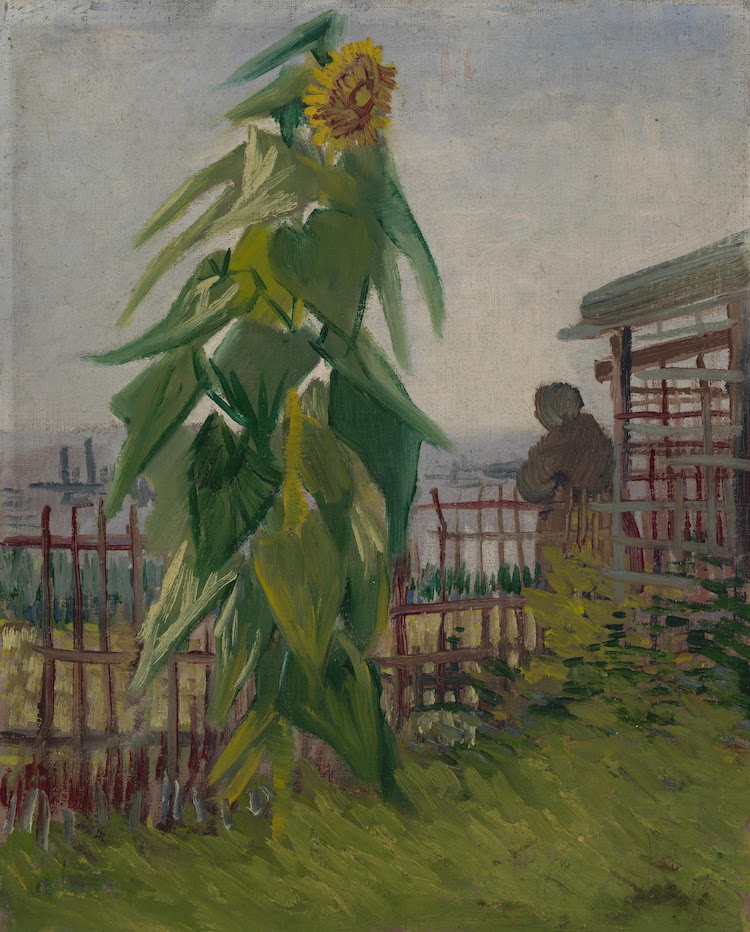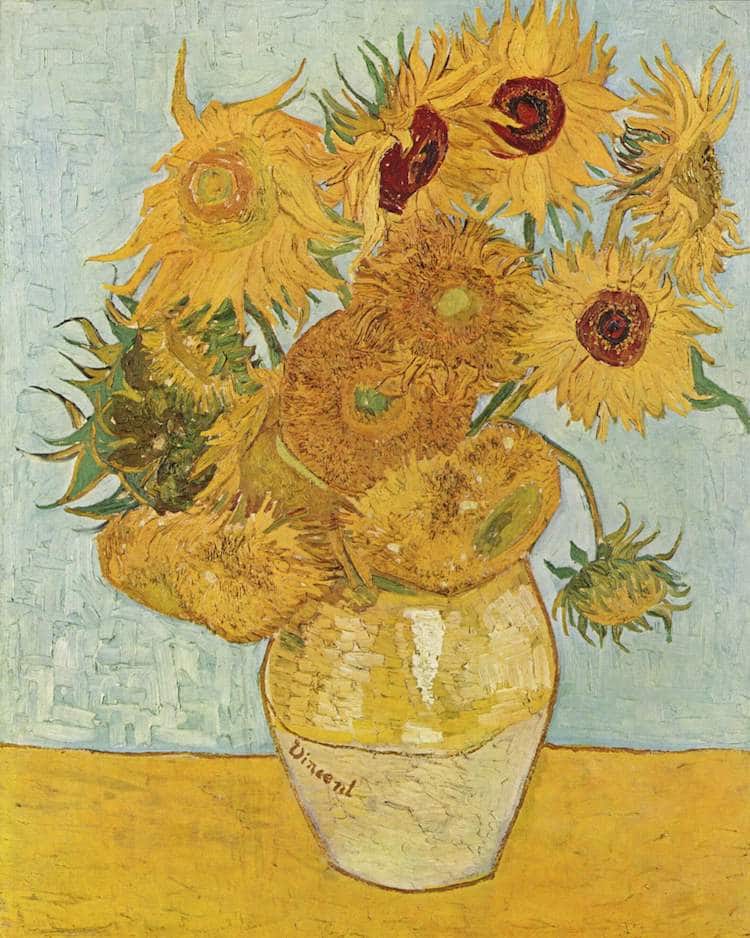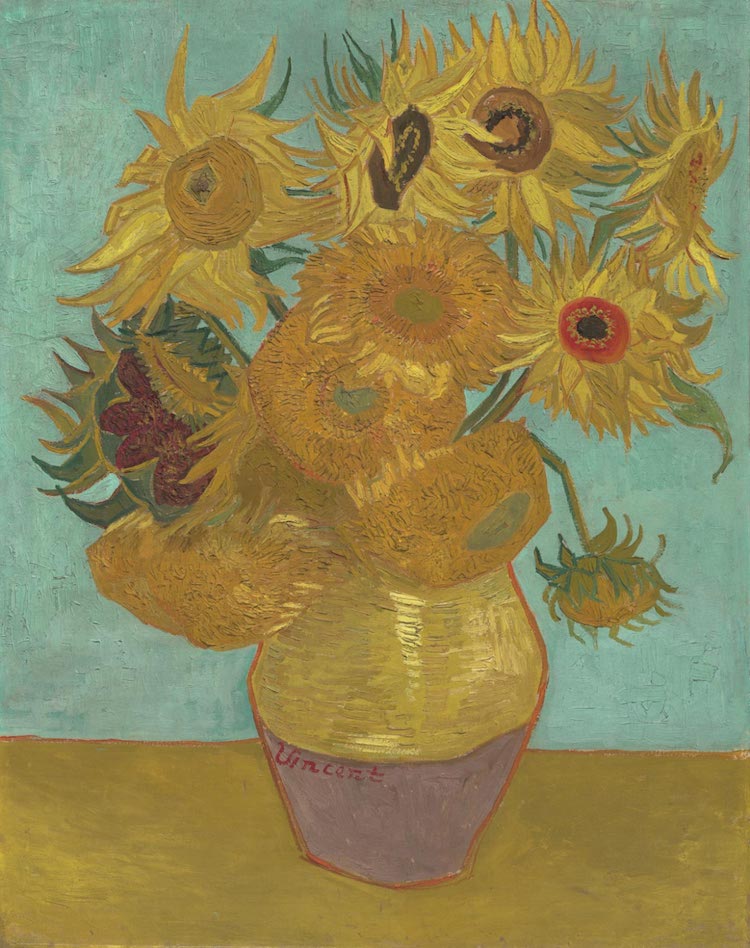
If you're familiar with the work of Vincent van Gogh, you've undoubtedly seen his Sunflower paintings. Whether resting on a flat surface or propped up in a vase, sunflowers star in some of Van Gogh's most famous still life depictions.
Van Gogh repeatedly revisited these cheerful yellow subjects, culminating in two series: his Paris Sunflowers and his Arles Sunflowers. Though strikingly different in color palette and composition, both series explore the artist's admiration for the flowers—a connection that he continuously cultivated over the course of his short career.
Van Gogh's Love of Sunflowers

Paul Gauguin, “Van Gogh Painting Sunflowers,” 1888 (Photo: Wikimedia Commons Public Domain)
In 1886, when he was 33 years old, Van Gogh permanently relocated to France. After seeing no artistic success in the Netherlands—his native country—he decided to join his art dealer brother Theo in Paris. While Van Gogh did not find life in the French capital particularly enjoyable (he told his brother that living in Paris put him at risk of becoming “utterly numbed”), he found solace in sunflowers.

Vincent van Gogh, “Allotment with Sunflower,” 1887 (Photo: Van Gogh Museum Van Gogh Museum, Amsterdam -Vincent van Gogh Foundation Public Domain)
In 1886 and 1887, Van Gogh began incorporating the flowers into his work. Some stand-alone pieces, like Roses and Sunflowers and Allotment with Sunflower, do not focus solely on the flowers; instead, they're simply part of the still life or scene. However, by late summer 1887, Van Gogh was dedicating entire canvases to sunflower studies, as evident in his Paris series.
Paris Series

Vincent van Gogh, “Four Withered Sunflowers,” 1887 (Photo: Wikimedia Commons Public Domain)
While in Paris, Van Gogh painted four still lifes of sunflowers: Four Withered Sunflowers, two pieces simply titled Sunflowers, and an oil study called Sunflowers Gone to Seed. Each piece depicts cut flowers resting on a floor or table, emphasizing the intricate detail of their heads and stems and enabling Van Gogh to experiment with color and stroke.
Noting that he found “comfort in contemplating the sunflowers,” these works were among Van Gogh's personal favorites. Equally interested in his Sunflowers was friend and fellow Post-Impressionist Paul Gauguin. Gauguin acquired two pieces from the Paris Sunflowers series—and, according to a letter sent from Van Gogh to his brother, was keen to collect more.
Van Gogh, however, did not relent. “I’m keeping my canvases here, and I’m categorically keeping those sunflowers of mine,” he said. “He already has two of them, let that be enough for him.”

Vincent van Gogh, “Sunflowers, 1887 (Photo: The Metropolitan Museum of Art Public Domain)
Arles Series

Vincent van Gogh, “Still Life: Vase with Twelve Sunflowers,” 1888 (Photo: Wikimedia Commons Public Domain)
By 1888, Van Gogh was fed up with feeling “utterly numbed” in Paris. So, he headed south, settling in the idyllic commune of Arles. Here, he found increased artistic inspiration, prompting him to revisit and reimagine his favorite Sunflower subjects. “I’m painting with the gusto of a Marseillais eating bouillabaisse,” he wrote to Theo in 1888, “which won’t surprise you when it’s a question of painting large Sunflowers.”
This newfound “gusto” culminated in his Arles Sunflowers series, a five-piece collection featuring studies of flowers in vases. In addition to the way in which the sunflowers are arranged, these pieces differ from the Paris series in color. In Arles, Van Gogh rendered the flowers in various shades of yellow, “demonstrat[ing] that it was possible to create an image with numerous variations of a single color, without any loss of eloquence.”

Vincent van Gogh, “Still Life: Vase with Fourteen Sunflowers,” 1888 (Photo: Wikimedia Commons Public Domain)
Though, today, these works are known as a series, this was not intended by Van Gogh. In fact, two of the so-called Arles Sunflowers (Still Life: Vase with Twelve Sunflowers and Still Life: Vase with Fourteen Sunflowers) were part of another series. Along with La Berceuse, a portrait of Augustine Roulin (one of Van Gogh's regular sitters), this pair of paintings was to make up part of a three-piece installation.

Vincent van Gogh, “La Berceuse,” 1889 (Photo: Wikimedia Commons Public Domain)
Van Gogh detailed their arrangement in a letter, supplementing a brief written description with a quick sketch. “If you arrange them this way, namely La Berceuse in the middle and the two canvases of sunflowers to the right and left, it makes a sort of triptych,” he said. “And then the yellow and orange tones of the head will gain in brilliance by the proximity of the yellow wings.”

Excerpt from a letter by Vincent van Gogh to his brother Theo. Saint-Rémy, 22 May 1889 (Photo: Wikimedia Commons Public Domain)
In 1889, Van Gogh produced copies of these two Sunflower paintings. Known as the Repetitions, these pieces retain the original compositions but feature slight alterations in tone and brushwork.

Vincent van Gogh, “Still Life: Vase with Twelve Sunflowers,” 1888 (Photo: Philadelphia Museum of Art Fair Use)

Vincent van Gogh, “Still Life: Vase with Fourteen Sunflowers,” 1888 (Photo: Wikimedia Commons Public Domain)
Between his original paintings and these Repetitions, Van Gogh intended to produce 12 Sunflower paintings. “If I carry out this idea there will be a dozen panels,” he wrote. “So the whole thing will be a symphony in blue and yellow.”
Why did Van Gogh want to create such a prolific series of Sunflowers? To the artist, this “symphony of blue and yellow” would make the perfect addition to the Yellow House, his home in Arles and the site of his proposed artists' colony. Specifically, he hoped that these decorations would please Paul Gauguin, his first—and last—recruit.

Vincent van Gogh, “The Yellow House,” 1888 (Photo: Wikimedia Commons Public Domain)
The Legacy of the Sunflowers
Much like his dream of a shared studio, Van Gogh's desire for a dozen Sunflowers did not reach fruition. By the time of his death, he had produced seven Sunflowers in Arles. Unfortunately, only five (two originals and three Repetitions) remain in the public sphere today, as one has been in a private collection since 1948 and another was destroyed by a fire in 1945.
Still, don't expect to see the remaining five paintings at once. According to Van Gogh expert Martin Bailey, it's unlikely that the pieces—which are located in London's National Gallery, the Van Gogh Museum in Amsterdam, and other institutions around the world—will ever be displayed together. “First, they are fragile works, and for conservation reasons they either cannot travel at all or are only allowed to in very exceptional circumstances,” he says. “Secondly, they are probably the most popular paintings in all the galleries that own them, so the owning institutions are very reluctant to allow them to leave.”
Though their inability to travel may be disappointing, it may just make the experience of seeing a single Sunflowers painting all the more magical.
Related Articles:
Handmade Candles Capture the Enchanting Glow of Van Gogh’s Famous Paintings
Beautiful Van Gogh Notecards Let You Channel the Artist’s Love of Letter-Writing
This Exhibit Gives Visitors the Experience of Stepping Inside Van Gogh’s Paintings
























































































